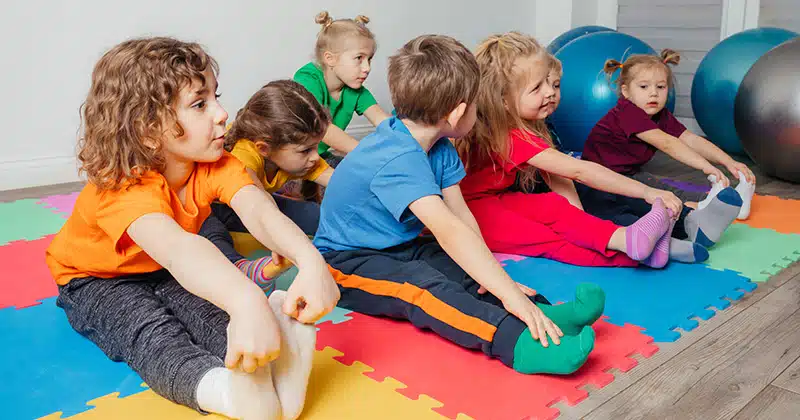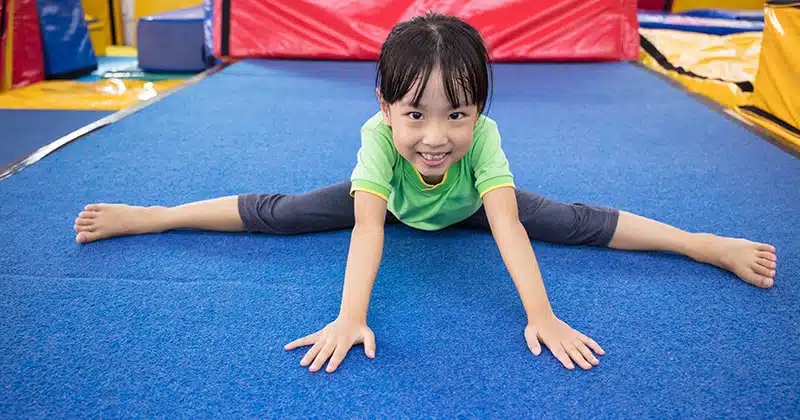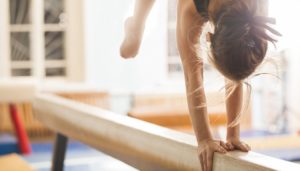If you teach gymnastics to very young children, how do you structure classes so they get the most out of every session? It’s really all about getting your youngest students comfortable with movement and improving their spatial awareness while having fun.
In this article, you’ll learn how to teach basic movements. You’ll also learn to set up obstacle courses and get tips on adding dance and creative movement.
Our preschool gymnastics lesson plans will get you started with examples.
Read expert advice on reviewing your overall plan for the lesson term. You’ll even find ways to make more time for lesson planning.
But first, you should understand the reasons behind teaching gymnastics to preschool-age children.
Benefits of Gymnastics for Preschoolers
Gymnastics lessons for preschoolers provide a wide range of benefits. Most people are concerned with developing kids’ gross motor skills first. And, of course, this is an enormous plus.
However, with gymnastics, young children can develop balance and coordination. These skills translate to other activities, like sports and dance. They also enhance overall physical condition.
It can also help kids learn where their bodies are in space (proprioception). Spatial awareness is important not only for their own safety but for simply being present within a group.
Gymnastics also helps children develop cognitively. It encourages them to think about breaking down movement into deliberate steps.
It even gets them exploring concepts like mirror imagery and being upside down. These spatial ideas will help them later with subjects like geometry and art.
There are social and emotional benefits to gymnastics, too. Kids learn about working as a group, forming lines, waiting their turn, and being polite to others. They also become more persistent in the face of making mistakes.
They begin to understand that skills can take time to master, but it’s worth trying.
RELATED ARTICLE: How to Market a Gymnastics Studio on Social Media

Key Elements of a Preschool Gymnastics Lesson Plan
Gymnastics lessons are most successful for all involved when they are approached with a plan. Each lesson can be part of a larger goal, with smaller achievements built into every class.
For example, the goal for a semester might be to navigate an entire obstacle course (more below) without falling or knocking anything over. Individual lessons could focus on individual elements of the course. Elements might include climbing structures or walking across a low balance beam.
The lesson plan for any given day should typically include the same routine, such as:
- Lining up and attendance (focusing attention)
- Warming up and getting ready to move
- Introducing the skill or theme of the day and why it’s important
- Development of the skill (learning and practicing)
- Exploring the skill in new or fun ways (e.g., adding challenges or music)
- Cooling down and reflecting before heading home
The cool-down portion might incorporate some questions about what they learned that day. It could also prepare kids for what to expect in the next class.
Example Lesson Plan 1: Introduction to Basic Movements
Say your lesson is for three and four-year-olds, and the goal is to introduce basic movements. How would you structure the class?
Start with a warm-up. This gets kids into the habit of warming up before more intense movement, which is helpful as they progress with age and skill level.
Remember, warm-up time can include some stretching. But it should also get the blood moving and help students concentrate for the rest of the class.
Some warm-up movements might include:
- Bending the knees and straightening
- Twisting from the waist
- Making arm circles in each direction
- Touching the toes
- Reaching the arms overhead or side-to-side
- Reviewing left vs. right while pointing and flexing hands and feet
Next, you can move on to the fundamentals you want to teach in that class. For instance, you might want to cover three different types of movement:
- Jumps
- Rolls
- Balances
Once you demonstrate the basics and students get the hang of them, you can add some fun challenges, like:
- Jumping in different directions, not just forward
- Alternating turns with different rows or every other kid
- Rolling in many directions like a ball
- Balancing on one foot in different poses
- Stringing fundamental movements together in a sequence
- Adding simple rhythmic elements, like claps with or between moves
RELATED ARTICLE: How to Teach Gymnastics for Kids Tips and Routines
Example Lesson Plan 2: Creative Movement and Dance
A major element of gymnastics as kids get older is music. Adding creative movement and dance elements to your lesson is a great way to introduce this concept. Plus, it gives basic movements a new dimension and makes the class more exciting.
You don’t have to start from scratch with this type of class.
In fact, it will help kids build skills if you piggyback on basic movement classes. You can use the same moves you develop in other lessons. Then, add music or creative scenarios to take them in a new direction.
For example, if you’re working on jumping skills, have them match tiny or great big jumps with your chosen music. Vary the tempo and direction. Ask students to listen to the beat and jump in rhythm with the music.
Kids could pretend to be different animals and explore how they think each would jump. Would a frog jump differently than a tiger? How does jumping on two legs compare to hopping or jumping from one leg to the other?
You can also incorporate dance by giving them a few choreographed steps to string together. This helps with memory development and introduces them to floor exercises. It also gives students a sense of accomplishment in the end.
RELATED ARTICLE: Trends That Will Affect Your Gymnastics Studio Business in 2024
Example Lesson Plan 3: Obstacle Course and Coordination
Using an obstacle course is an excellent way to teach gymnastics skills and build coordination. Kids don’t necessarily realize they’re learning specific elements because they’re so busy having fun on the course.
Until your students have some experience working with obstacle courses, keep them short. You can always add elements as lessons progress or string several courses together later.
Some ideas for your obstacle courses include:
- Flat forward or backward rolls
- Rolling on a wedge/ramp
- Walking on a low balance beam
- Hopscotch jumping
- Leaping over low obstacles
- Climbing up small structures
- Chin-ups or swinging from a bar
- V-sits or other seated poses
- Short runs between elements
- Landing in a hula hoop on the ground
The idea is to alternate different kinds of movements at varying levels.
You can set up side-by-side obstacle courses and have teams compete against each other. Or you can pair students to help one another through the course.
Either way, you add an element of teamwork, which is also important.

5 Tips to Start Planning Your Preschooler Gymnastics Lessons Today
Ready to tackle some creative preschool gymnastics lesson plans? Here are five things you can do right now to get started and make your lessons more successful:
1. Set Goals.
Think about what your overall goals are for the semester or term. How can you break them down into chunks to help students reach those goals bit by bit over multiple weeks?
2. Assess Skill Level.
What is the skill level of your students? Is there a wide range of ages or abilities? If so, you may want to create several pathways based on skills so every kid feels confident at the end of the lesson.
You might divide them into numbered groups and present the skill differently at each level. Number ones might be working on rolls with assistance, twos might be working on rolling into a standing position, and threes might be learning dive rolls.
3. Incorporate Social Development.
In addition to learning movement, what social skills do your students need help with? Learning to take turns, respect personal space, or keep trying when something is difficult can benefit their everyday lives.
How can you incorporate these elements into your lesson plans each week?
4. Establish Consistency.
Kids thrive on routine. Try using the same warm-up and cool-down sequence in every class. This lets kids focus on getting more out of it. They don’t have to worry about memorizing or keeping up with new steps. They can even practice it at home.
5. Utilize Management Software.
Creating thoughtful gymnastics lesson plans takes time and concentration. If you own or manage a gymnastics studio, it can be tough to find either of those things.
Using studio management software like The Studio Director can help. It will streamline and organize your administrative tasks, letting you focus on your students, which is your ultimate mission.
RELATED ARTICLE: How to Run a Successful Gymnastics Studio


